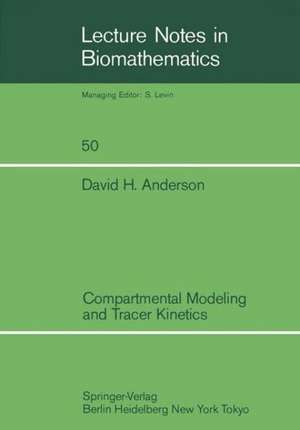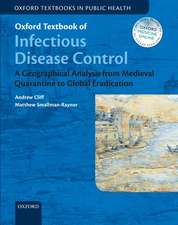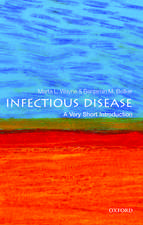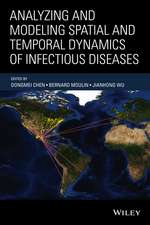Compartmental Modeling and Tracer Kinetics: Lecture Notes in Biomathematics, cartea 50
Autor David H. Andersonen Limba Engleză Paperback – iul 1983
Din seria Lecture Notes in Biomathematics
-
 Preț: 378.54 lei
Preț: 378.54 lei -
 Preț: 380.45 lei
Preț: 380.45 lei -
 Preț: 413.37 lei
Preț: 413.37 lei -
 Preț: 390.63 lei
Preț: 390.63 lei -
 Preț: 396.24 lei
Preț: 396.24 lei -
 Preț: 387.38 lei
Preț: 387.38 lei -
 Preț: 385.08 lei
Preț: 385.08 lei - 5%
 Preț: 366.56 lei
Preț: 366.56 lei -
 Preț: 384.70 lei
Preț: 384.70 lei -
 Preț: 388.13 lei
Preț: 388.13 lei -
 Preț: 394.29 lei
Preț: 394.29 lei - 5%
 Preț: 389.93 lei
Preț: 389.93 lei - 5%
 Preț: 370.74 lei
Preț: 370.74 lei -
 Preț: 384.86 lei
Preț: 384.86 lei -
 Preț: 387.96 lei
Preț: 387.96 lei -
 Preț: 404.29 lei
Preț: 404.29 lei -
 Preț: 391.61 lei
Preț: 391.61 lei -
 Preț: 384.48 lei
Preț: 384.48 lei -
 Preț: 384.48 lei
Preț: 384.48 lei -
 Preț: 383.71 lei
Preț: 383.71 lei -
 Preț: 379.68 lei
Preț: 379.68 lei -
 Preț: 384.09 lei
Preț: 384.09 lei -
 Preț: 405.66 lei
Preț: 405.66 lei -
 Preț: 379.48 lei
Preț: 379.48 lei -
 Preț: 400.65 lei
Preț: 400.65 lei -
 Preț: 385.25 lei
Preț: 385.25 lei -
 Preț: 390.25 lei
Preț: 390.25 lei -
 Preț: 395.47 lei
Preț: 395.47 lei -
 Preț: 378.71 lei
Preț: 378.71 lei -
 Preț: 382.95 lei
Preț: 382.95 lei - 15%
 Preț: 578.01 lei
Preț: 578.01 lei -
 Preț: 380.84 lei
Preț: 380.84 lei -
 Preț: 405.66 lei
Preț: 405.66 lei -
 Preț: 399.12 lei
Preț: 399.12 lei -
 Preț: 410.66 lei
Preț: 410.66 lei -
 Preț: 385.62 lei
Preț: 385.62 lei - 5%
 Preț: 371.10 lei
Preț: 371.10 lei -
 Preț: 378.71 lei
Preț: 378.71 lei -
 Preț: 386.99 lei
Preț: 386.99 lei -
 Preț: 401.61 lei
Preț: 401.61 lei -
 Preț: 350.30 lei
Preț: 350.30 lei -
 Preț: 383.33 lei
Preț: 383.33 lei -
 Preț: 408.54 lei
Preț: 408.54 lei -
 Preț: 398.53 lei
Preț: 398.53 lei -
 Preț: 399.67 lei
Preț: 399.67 lei -
 Preț: 384.86 lei
Preț: 384.86 lei -
 Preț: 401.61 lei
Preț: 401.61 lei -
 Preț: 392.60 lei
Preț: 392.60 lei -
 Preț: 406.05 lei
Preț: 406.05 lei
Preț: 391.79 lei
Nou
Puncte Express: 588
Preț estimativ în valută:
74.98€ • 81.42$ • 62.98£
74.98€ • 81.42$ • 62.98£
Carte tipărită la comandă
Livrare economică 22 aprilie-06 mai
Preluare comenzi: 021 569.72.76
Specificații
ISBN-13: 9783540123033
ISBN-10: 3540123032
Pagini: 316
Ilustrații: IX, 304 p.
Dimensiuni: 170 x 244 x 17 mm
Greutate: 0.5 kg
Editura: Springer Berlin, Heidelberg
Colecția Springer
Seria Lecture Notes in Biomathematics
Locul publicării:Berlin, Heidelberg, Germany
ISBN-10: 3540123032
Pagini: 316
Ilustrații: IX, 304 p.
Dimensiuni: 170 x 244 x 17 mm
Greutate: 0.5 kg
Editura: Springer Berlin, Heidelberg
Colecția Springer
Seria Lecture Notes in Biomathematics
Locul publicării:Berlin, Heidelberg, Germany
Public țintă
ResearchCuprins
Section 1. Compartmental Systems.- 1A. Introduction.- 1B. Preliminary definitions.- 1C. Tracer experiments.- 1D. History of compartmental analysis.- Section 2. Elementary Compartmental Models.- 2A. Drug kinetics.- 2B. Leaky fluid tanks.- 2C. Diffusion.- 2D. Solute mixture.- Section 3. First-Order Chemical Reactions.- Section 4. Environmental Studies.- 4A. Kinetics of lead in the body.- 4B. The Aleut ecosystem.- Section 5. Nonlinear Compartmental Models.- 5A. Continuous flow chemical reactor.- 5B. Reaction order.- 5C. Other nonlinear compartmental models.- Section 6. The General Compartmental Model.- Section 7. Tracer Kinetics in Steady-State Systems.- 7A. The tracer equations.- 7B. Linear compartmental models..- Section 8. Uptake of Potassium by Red Blood Cells.- Section 9. Standard Types of Tracer Experiments.- 9A. Tracer concentration equations.- 9B. Tracer specific activity equations.- Section 10. Analytical Solution of the Tracer Model.- 10A. The general solution of the model.- 10B. Nonnegativity of the solution.- Section 11. System Structure and Connectivity.- 11A. The connectivity diagram.- 11B. Common compartmental systems.- 11C. Strongly connected systems.- Section 12. System Eigenvalues and Stability..- 12A. Nonpositive eigenvalues ..- 12B. The smallest magnitude eigenvalue.- 12C. Symmetrizable compartmental matrices and real eigenvalues.- 12D. Distinct eigenvalues.- 12E. Compartmental model stability.- 12F. Bounds on the extreme eigenvalues.- Section 13. The Inverse of a Compartmental Matrix.- 13A. Invertibility conditions.- 13B. A Neumann series for the inverse matrix.- 13C. Matrix inequalities.- Section 14. Mean Times and the Inverse Matrix.- 14A. Mean residence times.- 14B. The compartmental matrix exponential.- 14C. Further properties of mean residence time.- 14D. System Mean residence time.- Section 15. Solution of the Steady-State Problem for SEC Systems.- 15A. The tracer steady-state problem.- 15B. Ill-conditioned SEC systems.- 15C. An iterative procedure for SEC systems.- 15D. Updating the algorithm.- Section 16. Structural Identification of the Model.- 16A. The system (A, B, C).- 16B. The structural identification problem.- 16C. A simple identification example.- 16D. Realizations of impulse response functions.- 16E. Impulse response function structure.- 16F. Nonlinear identification equations.- 16G. A three compartment model.- 16H. A four compartment model.- Section 17. Necessary and Sufficient Conditions for Identifiability.- 17A. Model identifiability.- 17B. Necessary conditions.- 17C. Sufficient conditions.- Section 18. A Simple Test for Nonidentifiability.- 18A. Counting nonzero transfer function coefficients.- 18B. Coefficient structure.- 18C. Further refinements of formula (18.4).- 18D. The nonidentifiability test.- 18E. Tighter bounds on the number of independent equations.- Section 19. Computation of the Model Parameters.- 19A. Local identifiability.- 19B. Newton’s method and modifications.- 19C. The Kantorovich conditions.- 19D. An example.- Section 20. An Alternative Approach to Identification.- 20A. A new identification method.- 20B. The component matrices of A.- 20C. The identification technique using component matrices.- 20D. Identification of a lipoprotein model.- 20E. The identification technique using modal matrices.- 20F. Identification of a pharmacokinetic system.- 20G. Spectral sensitivity of a linear model.- Section 21. Controllability, Observability, and Parameter Identifiability.- 21A. The control problem.- 21B. Completely controllable systems.- 21C. Completely observable systems.- 21D.Realizations and identifiability.- 21E. A third method of identifiability.- Section 22. Model Identification from the Transfer Function Equations.- 22A. Form of the nonlinear equations.- 22B. Coefficients of the transfer fuction.- 22C. The nonlinear algebraic equations for the identification problem.- 22D. Necessary conditions for positive solutions of the nonlinear system.- 22E. Refined necessary conditions.- 22F. Additional properties of the nonlinear algebraic system.- 22G. An iterative scheme for solving F(?) = 0.- 22H. Triangularization of F(?) = 0.- 22I. Uniqueness of solution F(?) = 0.- Section 23. The Parameter Estimation Problem.- 23A. The basic estimation problem.- 23B. A lipoprotein metabolism model.- 23C. Nonlinear least-squares.- 23D. Initial parameter estimates.- 23E. Method of moments.- 23F. Other methods of parameter estimation.- 23G. Positive amplitudes.- 23H. Curve-fitting sums of exponentials is ill-posed.- 23I. Fitting the differential equation model directly to data.- 23J. Modulating function method.- 23K. An antigen — antibody reaction example.- 23L. Additional literature on fitting of differential equations to data.- Section 24. Numerical Simulation of the Model.- 24A. Compartmental model simulation.- 24B. A three compartment thyroxine model.- 24C. Numerical integration methods and some inadequacies.- 24D. Implicit methods ..- 24E. Determining model stiffness.- Section 25. Identification of Compartment Volumes.- 25A. The basic single exit compartmental model.- 25B. Readily identifiable parameters.- 25C. The catenary single exit system.- 25D. Estimation of compartmental volumes.- 25E. Creatinine clearance model.- 25F. Shock therapy.- 25G. Bounds and approximations on compartmental volumes.- Section 26. A Discrete Time Stochastic Model of aCompartmental System.- 26A. The Markov chain model.- 26B. The liver disease model.- 26C. Simulation of the hepatic system.- 26D. Mathematical analysis of the model.- 26E. Parameter estimation.- 26F. Discussion.- Section 27. Closing Remarks.












